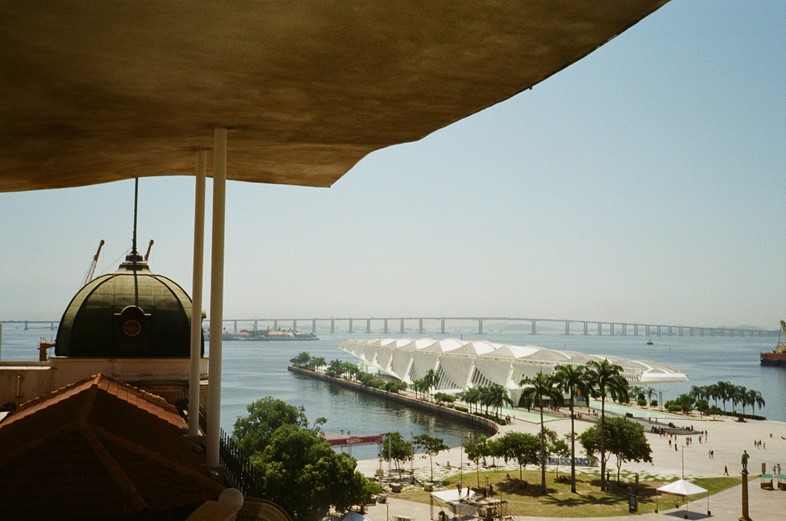A guide to the best restaurants, bars, galleries, and shopping in Brazil’s ‘Marvellous City’
Introducing a series of alternative city guides, specially curated for the cultivated traveller.
All cities are defined by the push-and-pull relationship between past and future, tradition, innovation and change, but in Rio de Janeiro you can feel it more than most. Masterpieces of modernist architecture – from concrete tower blocks, to the Maya-inspired cone of the ‘New Cathedral’ – are set against a backdrop of steep, lush-forested mountains, like something from a prehistoric landscape, while the remnants of Portuguese colonial sites and today’s sprawling favelas serve as a reminder of Brazil’s complex political history. Above it all, the famed Cristo Redentor has stood with its arms open wide since 1931, but even this speaks to the many facets of the country’s second-most-populous city. Depending who you ask, the towering monument is a tribute to Catholicism, a nod to the combined powers of science, art, and spirituality, or a universal welcome to new arrivals via Guanabara Bay.
From its vantage point atop the Corcovado mountain, the Cristo Redentor also overlooks much of Rio’s South Zone, or Zona Sul. Concentrated along sparkling coasts, Zona Sul is home to many favourite neighbourhoods of locals (AKA cariocas) and tourists alike. These range from the upscale Leblon and Ipanema – immortalised in the bossa nova classic “The Girl from Ipanema” – to Copacabana and its world-famous beach (if you’re looking for a quiet, romantic walk along the sand, maybe give this one a miss). Even outside of Carnival – when these neighbourhoods explode with music, costumes, and the colours of rival samba schools – the streets are filled with a unique energy at all times of day, with cariocas starting their all-important workouts in the early hours of the morning, and spilling out of bars late into the night.
Below, you’ll find some of the best places to eat, drink, shop, and enjoy local culture, to make the most of your time in Rio de Janeiro.

Museu de Arte do Rio
For a primer on the local culture of Rio, and its ongoing evolution, you can’t do much better than the Rio Museum of Art (MAR). The building itself is a testament to the city’s blend of past, present, and future, spanning two buildings in the historic square Praça Mauá – one a listed mansion, and the other a repurposed modernist bus station, linked by a striking roof that looks to the nearby waves for inspiration.
Inside, the story continues. As the first art collection conceived specifically for the municipality of Rio de Janeiro, MAR’s archive pays tribute to the city’s cultural legacy via thousands of objects, including extravagant carnival costumes, bossa nova records, and spiritual artefacts. At the same time, its exhibitions push boundaries via photography, film, painting and sculpture devoted to Rio’s diverse contemporary culture, from the “outlaw” funk scene of the favelas, to rising debates about the racial and postcolonial politics of the region.
A Gentil Carioca
Located not far from MAR, at the historic heart of Rio, the gallery A Gentil Carioca was founded in 2003 by the artists Márcio Botner, Ernesto Neto and Laura Lima. Since then, it’s become a cultural hub in Brazil, and a multidisciplinary melting pot for both emerging and established artists, whose work is showcased across two old townhouses.
Surrounded by the tight lanes and open markets of Saara – an area founded in the last century by Arabic and Jewish immigrants – the gallery offers a much more down-to-earth experience for visitors than many of its counterparts in the city’s fancier districts. If you’ve no time to pop inside, though, you can still enjoy the street-facing art on its Gentil Wall, where specially-curated works are featured for a few months at a time.

Bar Urca
In the shade of Sugarloaf Mountain – where, FYI, panoramic views of Rio de Janeiro are just a cable car ride away – is the traditional neighbourhood of Urca, much of which dates back to the 1920s. The eponymous Bar Urca serves a similarly classic menu of Brazilian specialities in its upstairs restaurant, from seafood with farofa, to Caipirinha cocktails. The real highlight, though, is the tiny bar downstairs, where locals like to order beers and empadas (a savoury pastry filled with seafood, cheese, or vegetables) and take them across the street to the bustling harbour wall, for a view of the boats in the nearby yacht club.
Acros da Lapa
Built in the 18th century to deliver fresh water from the Carioca river to the citizens of Rio de Janeiro, the Arcos da Lapa aqueduct is a landmark of the city centre. It’s also the site of some of Rio’s biggest festivities, both official and spontaneous, with vibrant crowds gathering around food and drink stalls for samba parties under the arches. Those looking for a more chilled night out can find plenty of bars in the vicinity of Lapa, like the low-key Celeste, which serves up a delicious selection of small plates and live DJ sets.
Mercado Moderno
The most iconic names of Brazilian modernism, like Joaquim Tenreiro, Lina Bo Bardi, and Oscar Niemeyer, deserve as much recognition as any European or American designer of the twentieth century. Mercado Moderno (or MAMO) stuffs a 19th-century townhouse in Lapa full of some of their greatest hits, alongside other rare examples of Brazilian furniture and design objects dating back to the 1950s, lovingly restored by local craftsmen.

The Museum of Images of the Unconscious
Located in a residential area of the city’s North Zone, the Museum of Images of the Unconscious (Museu de Imagens do Inconsciente) might be a bit off the beaten track for most tourists, but that suits its off-beat essence. The gallery is actually an offshoot of an Occupational Therapy wing created by psychiatrist Nise da Silveira in 1946, which rejected therapeutic methods of the time – including shock therapy and lobotomy – in favour of creative activities meant to access patients’ inner worlds, such as painting and sculpture.
The surprising results helped solidify links between art, mental health, and spirituality across the field, with supporters including Swiss psychoanalyst Carl Jung. Still an active centre for study and research to this day, the museum has exhibited thousands of artworks across the world, and invites visitors to view its collection or take part in creative workshops.
Carpintaria
Named after the former workshop it calls home in the grounds of the Rio de Janeiro Jockey Club (where the pristine racetrack makes for a slightly surreal setting) Carpintaria gallery is a bright and airy space that hosts art by internationally-acclaimed artists, ranging from Paula Rego to Trisha Brown and Matthew Lutz-Kinoy. Unsurprisingly, there’s also a focus on talented Brazilian artists, whose work is presented alongside their global counterparts in groups of two or three, generating original and interdisciplinary dialogues.
Eat at the Copa
The iconic Copacabana Palace has stood overlooking its namesake beach for just over a century, opening long before the highrises that have since sprung up beside it along the seafront. There’s a lot to be said for the hotel itself, which hosts some of Carnival’s main festivities, but the food is a particular highlight, whether you’re dining on chef Nello Cassese’s Michelin-star-winning Northern Italian menu at Ristorante Hotel Cipriani, or innovative sushi dishes and saké at the pan-Asian Mee (which boasts a Michelin star of its own).

Drink in Botafogo
Stroll through the bohemian Botafogo neighbourhood in the day, and you’ll likely be met with pleasantly lazy scenes – people grabbing a coffee at the Slow Bakery, mopeds zipping up quiet, tree-lined streets. Every night of the week, on the other hand, these streets will be filled with revellers from bars like Comuna or Bar Bukowski (which is billed as the oldest rock and roll house in Rio) though pretty much any casual spot is good if you just want to soak up the atmosphere with a few beers or a maté.
Ipanema Hippie Market
Rio has plenty of open-air markets, from Saara to Copacabana, but the Feira Hippie de Ipanema is among the most established. A holdover from a hippie hotspot in the 1960s, the market runs every Sunday, with vendors selling handmade arts and crafts, clothes, original paintings and sculptures, and furniture – perfect if your hair stood on end when you looked at the price tags in Mercado Moderno.
Arpoador at sunset
Arpoador beach, and its namesake rock formation that juts out into the Atlantic, is well-known as one of the best places to watch the sunset in Rio. In summer especially, when the sun disappears over the sea, cariocas join travellers from all over the world to sit on the warm stone, clapping and cheering as the last of the light drains out of the sky. Expect music, the smell of barbeque, and maybe even a dip in the dark sea to round out your visit.
